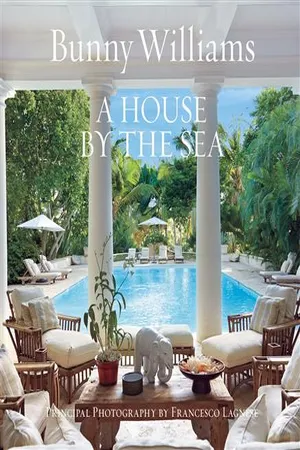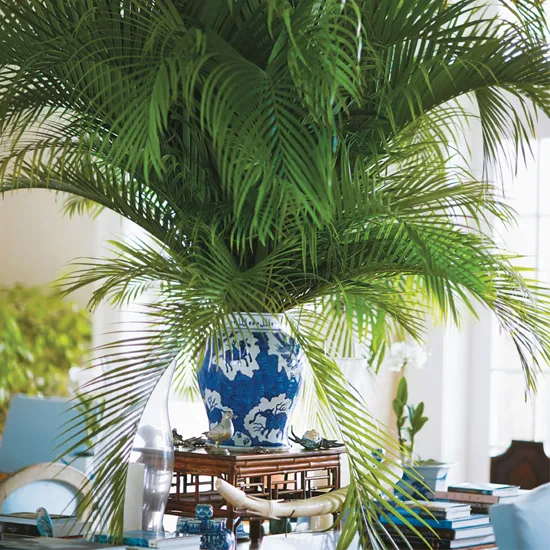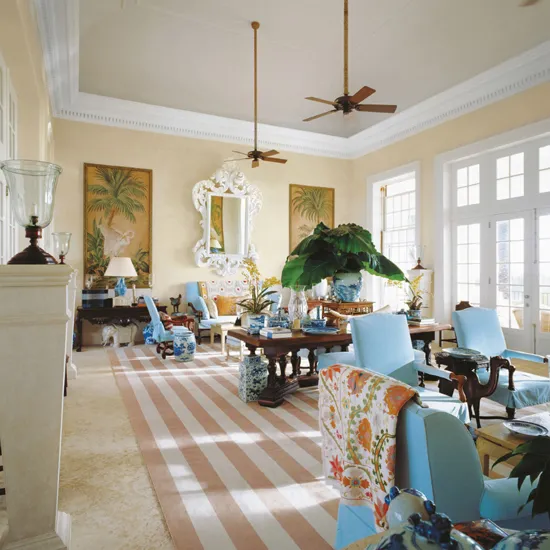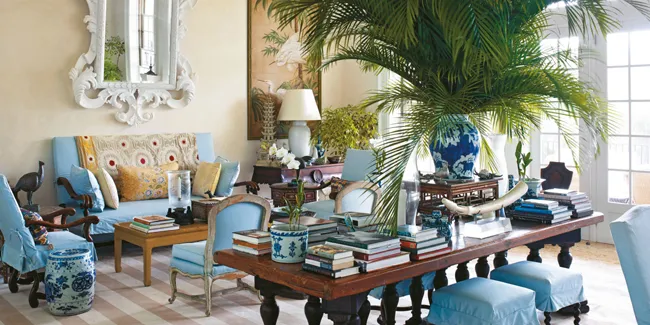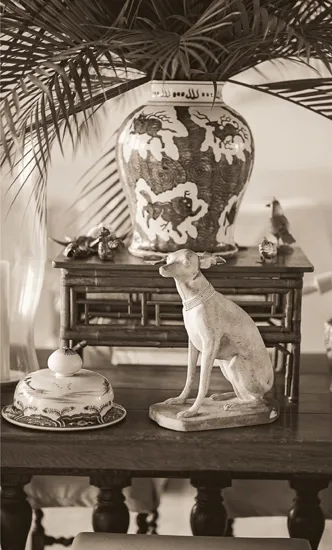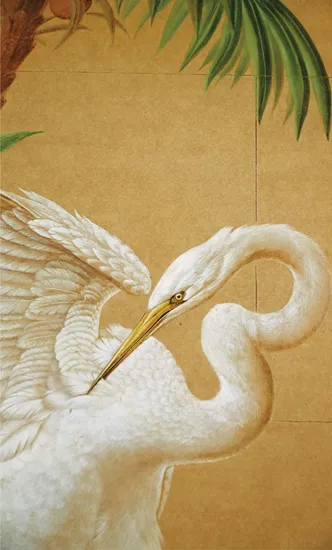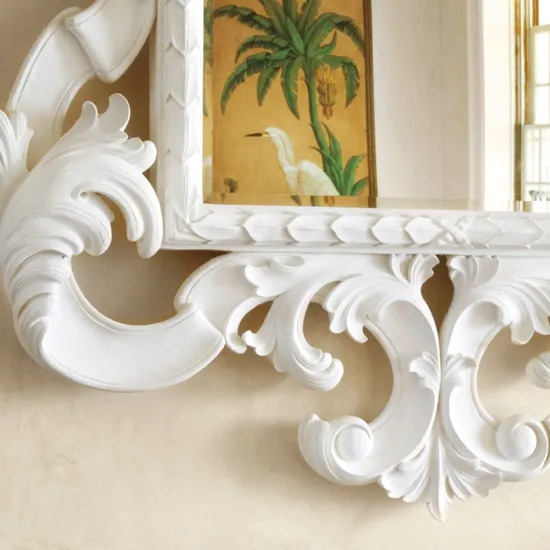![]()
II
DESIGNING AND DECORATING
“There are so many memories you have with furniture that you have collected and owned for a long time.”
![]()
THE FIRST STEP
Decorating a house can be a daunting task. With so many wonderful fabrics, rugs, furnishings, and colors to choose from, sometimes making choices can feel overwhelming. We wanted this house to have a casual, easy atmosphere, done in light colors that would feel cool in the tropical climate. After weeks of putting together the schemes for each room, I laid everything out and showed it to John. He looked for just a few minutes and then said he didn’t like it. My heart sank. We had a long conversation about decorating, and I started to understand that what John really loves is simplicity: white walls and sisal carpet, clean surfaces that create a background for the furniture, art, and the blue-and-white china he collects. He is an antiques dealer to the core. I promised him I would not overdecorate the house, but I did want to have color and some pattern. Luckily, he relaxed and put it in my hands.
One thing we agreed on—and had already—was furniture. When we decided to build a house in the tropics, part of our decision came from wanting to be in a warm climate, but another part came from wanting to furnish a home with treasures from John’s family house in New Jersey. The New Jersey house had recently sold, and we wanted a place for all the beautiful furniture and objects it once held. Before the house was emptied, we made a complete catalog of its contents. This is a good practice for any move: Measure and photograph each item you are keeping, and make an inventory by recording the information in a blank book that you have divided by categories (seating, artwork, lamps, etc.). An inventory book is like your own personal home-furnishings catalog. Once I had the inventory book, I did floor plans for each room in the new house and then began finding a home for each piece.
“We wanted a casual, easy atmosphere . . . that would feel cool in a tropical climate.”
![]()
OUR ISLAND LIVING ROOM
I started my plan with the living room, which is the largest interior space and on the second floor of the house. It is always good to start planning the living room first; if you think of how you want to use the space, and you plan accordingly, it will be the room you use the most. If you provide for a television, a desk, a sofa, and plenty of comfortable chairs arranged for conversation, you might never want to leave the room. The living room at La Colina is large: twenty-three feet wide by thirty-one feet long, with two doors and four windows along the long sides of the room and flat walls at each end. The ceilings are high (sixteen feet to the large cornice, with a five-foot curved tray, or recessed, ceiling above).
To make a room of this size, or any really large room, feel comfortable, one has to use large-scale furniture. I decided that two big furniture groups would sit at each end of the room, with an enormous walnut trestle table in the middle.
John had a fabulous high-backed, eighteenth-century Italian sofa (also walnut) that I set against one wall, with a pair of his high-backed Louis Quinze chairs on each side around a modern Chinese lacquer coffee table. For the other end of the room, I designed a high-backed sofa that would balance the Italian one. I added two large upholstered chairs and a pair of Italian chairs to this group, placing them around a matching coffee table. On the large trestle spanning the center of the room, I placed a blue-and-white Chinese vase filled with five-foot palm fronds. This detail would draw the eye up and allow one to feel the scale of the room. The table would also hold stacks of books, with some of our collection of art objects scattered among the stacks. I kept the walls of the room a simple, natural plaster one shade lighter than the coral stone floors. The stone floors continue out to the two large porches on each side of the living room. Extending the flooring to an outdoor space is a nice way to give a room more of an indoor/outdoor atmosphere, which is just what we did here.
“It is always good to start planning the living room first.”
![]()
TREASURE HUNTING
There are so many memories you have with furniture that you have collected and owned for a long time. John still remembers with amusement how, years ago, he and his business partner, Furlow Gatewood, found the trestle table on the second level of an antiques barn and managed to wrestle it out of the second floor, down an embankment, and into the back of a truck—only to realize it was much too big to fit into their shop on New York City’s Sixty-Eighth Street and Third Avenue. It ended up in New Jersey, in a large barn that served as John’s family’s pool house. A few years later, after photos of that house appeared in House Beautiful, John noticed that the table had been copied and was being offered for sale in a leading home-décor catalog. Now, restored and polished, the original table sits as the centerpiece of our living room.
Throughout the house we enjoy many such memories of the places where we found pieces, the people we met, and what we learned along the way. Buying on the Internet may be convenient, but it will never give you the same experience or stories to tell.
Since I had done thorough furniture floor plans for La Colina, I realized that, even with the many pieces John had from his New Jersey home, there were still some furnishings we needed to find. For instance, we did not have any artwork large enough for the walls over the sofas, so, on a trip to the annual furniture show in High Point, North Carolina, I scouted for mirrors. I found a rococo pair in the right size, but the carved wood frames had an awful finish. I imagined them painted white, as though they were made of plaster—very Dorothy Draper—and that was that. I then decided we needed large panels on either side of the two mirrors. Unable to find any antique ones we liked, we had a wonderful artist who works in John’s studio paint four-by-eight-foot panels of white birds and palm trees on brown kraft paper cut into squares, just as the old ones were. (In the eighteenth century, when the French, English, and Americans were doing a large trading business with China, it was very fashionable to commission hand-painted wallpaper panels to be installed in the great houses of Europe and America. Since the paper itself was handmade, it came in small sheets that were pieced together into large panels. These antique panels were my inspiration.)
A
“Throughout the house we enjoy many such memories of the places where we found pieces, the people we met, and what we learned along the way.”
A
“I imagined them painted white, as though they were made of plaster—very Dorothy Draper.”
![]()
A DESIGN FOR THE TROPICS
If you have formal furniture and decide you would like a more tropical look for it, try covering the pieces in inexpensive cotton canvas or duck. That is just what I did with the upholstered furniture we brought to Punta Cana for the living room. I covered all the sofas and chairs in the same fabric, a clear sky-blue, inexpensive, cotton duck I had found and immediately purchased a hundred yards of. These slipcovers gave even the eighteenth-century chairs a casual feel that was more appropriate for this airy house by the sea. John was initially shocked to see the original Bargello fabrics—which had made the furniture so formal—covered with humble cotton, but he ultimately came to love the effect.
Using the same fabric throughout this large room...
